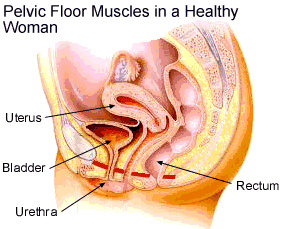Your Guide to the pelvic floor
[Content advisory: In depth discussions of vaginal and anal health, including negative health impacts]
People...I worry that my vagina isn’t as tight as it could be. Why? Because I recently read an article about women breaking their partner’s penis during intercourse due to their tightness. I realised I want my vagina to be registered as a lethal weapon. I want my Batcave to be equally as dangerous as Batman. Is that so much to ask?
It turns out that literally everyone has a pelvic floor. Regardless of what your genitals look like the following information will be relevant to you. However, I will be addressing vagina owners specifically, since most of the major risk factors regarding your pelvic floor are specific to vagina ownership.
So, fellow vagina owners let’s examine what exactly your pelvic floor muscles do and why we need them.
To start with, you don’t actually need to call them your Pelvic Floor Muscles, you can just refer to it as your pelvic floor since it’s literally the floor below your pelvis and happens to be made of muscles. It’s a pretty important part of your anatomy as well, since it basically keeps all your organs in the right place, and if you’re ever in a position to push a kid out of there it acts like one of the paddles on a pinball machine at flips that sucker so they come out facing the right way. Think of your pelvic floor as a trampoline for your innards, and if the springs start to sag or pop off, you’re in a bit of trouble.
Vagina owners have a pelvic floor with three holes in it; for your anus, urethra and vagina. The muscles of your pelvic floor work damn hard to keep those holes closed when they’re not in use, but occasionally damage can be caused through pregnancy, hysterectomy, childbirth, and perineal surgery. It can also be damaged by specific forms of exercise, such as water-skiing, bike riding and horse riding. So if you’re a horse-riding, water ski enthusiast who gave birth and then had a hysterectomy, you should probably give up on your pelvic floor completely and replace it with a concrete pelvic basement instead.
To be clear though, there are other contributing factors, such as hormones, family history, and age. If you damage your pelvic floor significantly, you have to worry about pelvic organ prolapse; or to put it less politely, your organs might start poking out of your vagina. Or alternatively, rectal prolapse, where your colon starts peeking out of your butthole. Or just some kind of fucked up hernias. Sexy, right? If this happens there’s a good chance you’ll need corrective surgery, since it’s pretty impossible to come back from any of these through the power of healing crystals and meditation.
This is where things start to get ugly. In recent years a new treatment for pelvic organ prolapse has started to become more popular. It’s called a Urogynaecological mesh, and it’s a permanent, plastic mesh like implant that’s meant to support you in all the places your body naturally can’t. Here’s the catch though, for whatever reason a LOT of women are having pretty massive health complications from these implants. When they’re initially offered the surgery, many aren’t informed that it will be permanent, and often require follow up surgeries. That doesn’t sound too bad right? Well, if you have the stomach for it I recommend reading the stories about these women who have gone through it. Full disclosure, if you’re a vagina owner, you may struggle to get to the end of that article without some whimpering and involuntary vagina clenching.
For those not brave enough to click that link, the short version is that this surgery can cause everything from nerve damage to the clitoris, skin conditions on the labia, an inability to walk, bed wetting, bruising of the buttocks and genitals, excruciating and constant pain, vaginal bleeding, inability to have sex, vaginal fistulas, necrotic flesh, pelvic scar tissue and so much more. Oh, and there’s no one in Australia who will reverse the surgery, so these women are looking at up to $50k to have a surgeon reverse the procedure in the U.S (this is on top of the nine previous surgeries they may have had to try and make the initial mesh insert work).
Having spoken to people in the health industry, the general consensus seems to be that this surgery was introduced with little to no evidence that it would be effective in the treatment of pelvic floor issues. Additionally it’s not uncommon for surgical mesh (wherever it’s placed) to become colonised by bacteria, meaning that people are subject to lifelong antibiotic suppression where removal isn’t possible. If you’re a vagina owner and you’ve ever been on antibiotics, there’s a good chance that you got thrush just from reading that sentence. All of this is probably a contributing factor in why the surgery is currently under investigation by a senate inquiry.
It’s important to note that mesh is not the only surgical option available for pelvic floor treatment; there are a variety of others that are comparatively safe with few ongoing negative impacts (outside the scope of normal surgical issues). So if you’re in a position where surgery is suggested, it’s not the end of the world. But it is crucial that you research the risks associated with the options you’re given. Too often women are told that they’re being overly dramatic, or encouraged to simply suck it up and soldier on, which means that issues like those that have arisen with mesh surgery go largely under-reported.
Okay, so you’re now well informed about the possible dangers of pelvic floor surgery. What if you’ve managed to keep your organs inside, but through no fault of your own you’ve still done some minor damage to your old organ trampoline? Well, the first thing you’ll notice is that all of your more embarrassing bodily functions will become that much more likely to embarrass you at an inopportune moment. Even mild pelvic floor damage can cause constipation (which in turn can make you strain more and thus do more damage). Or you might experience anismus (like vaginismus, but with your butt), where your muscles won’t relax enough for you to expel all your poop.
The most common symptom however is urinary incontinence. If you’ve ever peed a little when you coughed or sneezed, you’ll know exactly what this is. And here’s the fun part; guess what the medical profession has started recommending for urinary incontinence? If you guessed Urogynaecological mesh then you win a prize! A sad, burning, painful groin based prize.
So if you’ve noticed that you have difficulty pooping, farting or peeing you might have mild pelvic floor damage. Mild damage is often caused by childbirth, but it can also be impacted by obesity, excessive athleticism, asthma, menopause, diabetes and chronic constipation. Kind of sounds like pretty much everyone is at risk, right? Well that’s because they kind of are. 1 in 3 Australian women will experience pelvic floor dysfunction. That’s a lot of vaginas that are going through a special kind of hell.
Now, if you weren’t upset about this situation a minute ago, prepare to be really ticked off. So, you know how the whole pelvic floor thing is a massive health concern and vagina owners should be enrolled in some kind of pelvic floor health class from puberty? Well unfortunately what we get instead is ben-wa balls, sometimes called kegel balls. These are essentially tiny little weights that you train your vagina to lift by activating your pelvic floor. That part is fine, the issue is that until very recently these balls have been marketed solely as a way for women to be tighter for their man.
A woman’s health; it’s only a problem if it impacts the straight man she’s attached to. Despite the fact that kegel exercises can help to provide vagina owners with more intense orgasms and a stronger pelvic floor that's less prone to injury, we are instead marketed to through our insecurity. We are reminded that our pleasure comes second to the pleasure we can provide a penis. And for that narrative to sit on top of the legitimate health concerns that come from pelvic floor damage, well this is pretty much the point at which I Hulk out.
In a very rare moment the Australian Government decided to throw its money behind something worthwhile and helped to fund a website that provides support and advice about pelvic floor dysfunction. It includes information on the causes of pelvic floor dysfunction, as well as guides on ways to minimise your chances of doing damage in the future.
Crucially though, it has a downloadable PDF with medically designed exercises that help strengthen your pelvic floor. This is very important, because while it’s fun to do kegels while listening to Kevin Smith podcasts (just as a totally random example), studies have shown that for serious pelvic floor dysfunction it’s just not effective. If you think you have serious pelvic floor dysfunction, or know that you’re at risk of it, please see a trusted medical professional.
Your best option for treatment if you’re experiencing minor pelvic floor dysfunction is to see a specially trained women’s health physiotherapist. These are people who specialise in treating issues like pelvic dysfunction and can build a customised program of exercises to help your floor recover its strength (and the cost is usually offset by private health insurance).
And there you have it, dear readers; your guide to the pelvic floor. Horrific, isn’t it? Yeah. You’re welcome. There will be an article coming soon in which we examine all the different products available that position themselves as helping to strengthen and “tighten” your pelvic floor muscles, and how effective they may be. But remember, if you have medical concerns, please see a trusted health care provider.
I shouldn’t have to say this, but...I’m not a doctor.
That is all.
You may go now.













